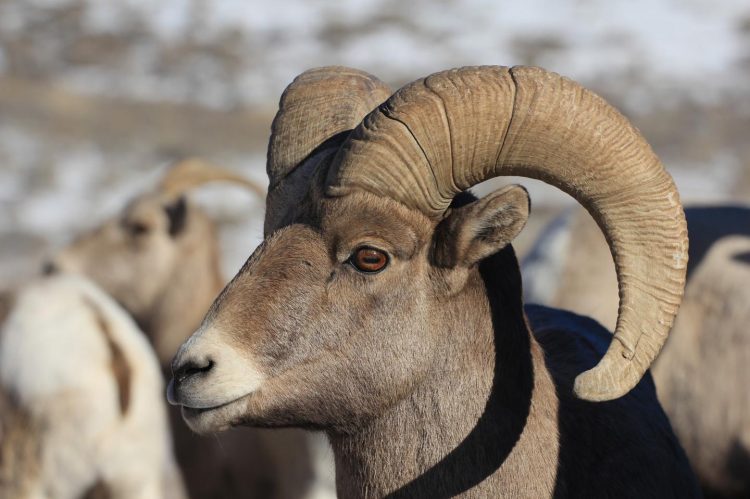Inbreeding not to blame for Colorado's bighorn sheep population decline

A bighorn sheep in Colorado is pictured. Credit: Ann Hough / U.S. Fish and Wildlife Service
Bighorn herds tend to be small and isolated in their mountain ecosystems, putting the animals at high risk for a genetic “bottleneck,” said Catherine Driscoll, a graduate student in the Department of Ecology and Evolutionary Biology at CU-Boulder and lead author of the study. Previous research has shown that inbreeding can weaken a population's immunity to disease across subsequent generations.
However, after using mitochondrial DNA data to analyze a diverse set of hereditary markers, researchers found that all five native herds in Rocky Mountain National Park (RMNP) are maintaining healthy levels of genetic variation compared to other bighorn populations across the western United States.
“There's been enough gene flow between the herds, primarily due to high ram migration, that the population has been genetically rescued,” Driscoll said.
The findings, which were recently published in the Journal of Wildlife Management, suggest that other factors such as nutritional deficiencies, habitat fragmentation and competition from encroaching mountain goats may play a more significant role in depressing bighorn population growth.
The researchers used DNA testing to examine genetic diversity across five separate RMNP herds. In particular, the study zeroed in on the Mummy herd, which experienced a severe population crash in the mid-1990s and has been especially slow to recover.
Although the Mummy herd is maintaining healthy levels of genetic variation, it may still carry higher exposure to stress factors due to its proximity to roads and trails on the eastern side of RMNP.
Colorado's bighorn population has trended downward since the 1800s, including a sharp 10.2 percent drop between 2001 and 2009. Wildlife managers have occasionally transplanted bighorns from other states in an attempt to restore herd numbers.
In addition to RMNP, bighorns can frequently be spotted at popular viewing destinations such as Mt. Evans, the Colorado National Monument and near Georgetown along Interstate 70.
###
Jeffry Mitton, a professor in the Department of Ecology and Evolutionary Biology at the University of Colorado Boulder; James G. Driscoll, a researcher at the Blue Basin Wildlife Sanctuary; Corey Hazekamp, a research assistant at the University of Massachusetts; and John D. Wehausen, a research associate at the University of California San Diego, co-authored the study.
The National Park Service, Rocky Mountain National Park, the National Science Foundation, the Rocky Mountain Nature Association, the Indian Peaks Wilderness Alliance and the University of Colorado Boulder provided funding for the research.
Contact:
Trent Knoss, CU-Boulder media relations, 303-735-0528
trent.knoss@colorado.edu
Media Contact
All latest news from the category: Ecology, The Environment and Conservation
This complex theme deals primarily with interactions between organisms and the environmental factors that impact them, but to a greater extent between individual inanimate environmental factors.
innovations-report offers informative reports and articles on topics such as climate protection, landscape conservation, ecological systems, wildlife and nature parks and ecosystem efficiency and balance.
Newest articles

Superradiant atoms could push the boundaries of how precisely time can be measured
Superradiant atoms can help us measure time more precisely than ever. In a new study, researchers from the University of Copenhagen present a new method for measuring the time interval,…

Ion thermoelectric conversion devices for near room temperature
The electrode sheet of the thermoelectric device consists of ionic hydrogel, which is sandwiched between the electrodes to form, and the Prussian blue on the electrode undergoes a redox reaction…

Zap Energy achieves 37-million-degree temperatures in a compact device
New publication reports record electron temperatures for a small-scale, sheared-flow-stabilized Z-pinch fusion device. In the nine decades since humans first produced fusion reactions, only a few fusion technologies have demonstrated…





















